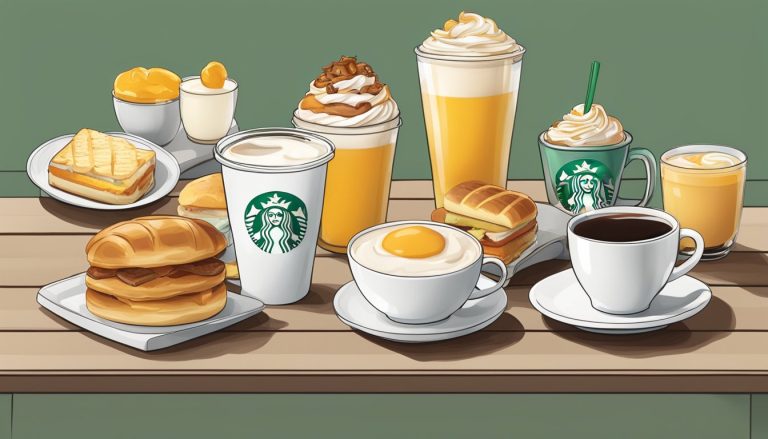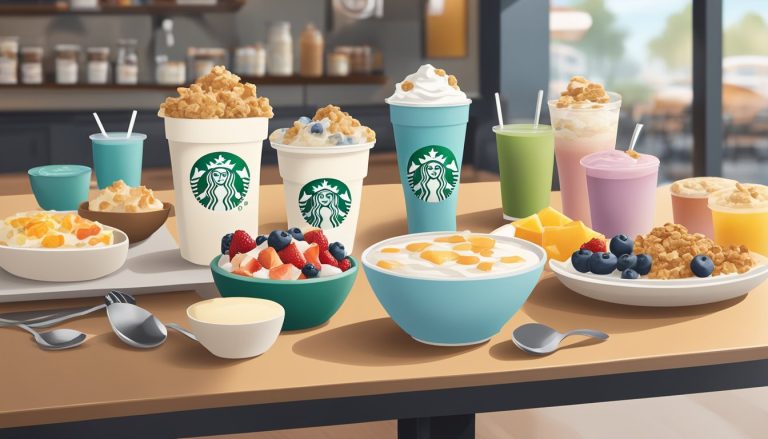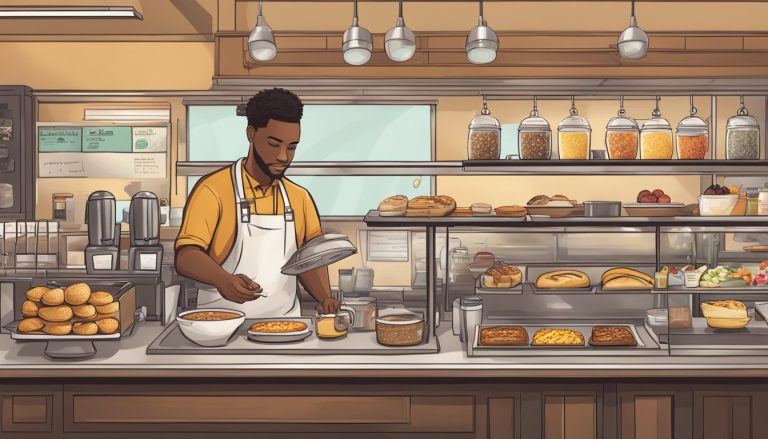Technology has revolutionized the way customers order breakfast at Starbucks. The coffee giant has embraced digital solutions to streamline the ordering process, enhance customer experience, and reduce wait times. Mobile apps and digital platforms now play a crucial role in how patrons interact with Starbucks for their morning meals.
Starbucks’ mobile app allows customers to place breakfast orders in advance, customize their selections, and pay without waiting in line. This technology-driven approach not only saves time for busy customers but also enables Starbucks to efficiently manage order flow and inventory. The app’s integration with the company’s rewards program further incentivizes digital ordering, creating a seamless experience for loyal patrons.
In-store kiosks and digital menu boards complement the mobile ordering system, providing additional touchpoints for customers to interact with Starbucks’ breakfast offerings. These technologies work together to create a more efficient and personalized ordering experience, reflecting Starbucks’ commitment to leveraging innovation in service of its customers.
Evolution of Starbucks and Technology

Starbucks has embraced technology as a core part of its business strategy since the early 2000s. The company recognized the potential of digital solutions to enhance customer experience and streamline operations.
In 2007, Starbucks took its first major steps into the digital realm by introducing in-store Wi-Fi and partnering with iTunes Music. This move positioned Starbucks as a tech-savvy brand and created a more inviting atmosphere for customers.
The launch of the Starbucks mobile app in 2009 marked a significant milestone in the company’s digital transformation. Initially designed to transition customers from physical loyalty cards to a digital platform, the app quickly evolved into a powerful tool for engagement and sales.
2012 saw the integration of digital gift cards into the Starbucks app, further expanding its functionality. This feature allowed customers to easily send and redeem gift cards, enhancing the gifting experience.
In 2015, Starbucks introduced mobile ordering and payment in the United States. This innovation allowed customers to place orders and pay through their smartphones, reducing wait times and improving efficiency.
By 2021, mobile ordering accounted for nearly 25% of US transactions, highlighting its widespread adoption and success. The app’s user-friendly interface and personalized features have contributed to its popularity among customers.
Starbucks continues to invest in technology, exploring areas such as artificial intelligence and data analytics to further improve customer experiences and operational efficiency. These ongoing efforts demonstrate the company’s commitment to staying at the forefront of digital innovation in the food service industry.
The Starbucks Mobile App

The Starbucks Mobile App revolutionized the coffee ordering experience, offering customers convenience, personalization, and rewards. It streamlined the ordering process and transformed store operations.
Overview of the Starbucks Mobile App
The Starbucks Mobile App launched in 2009, pioneering mobile payments in 2011 and introducing mobile pre-order and pay in 2014. This app allows customers to place orders, make payments, and earn rewards directly from their smartphones.
Key features include:
- Mobile ordering and payment
- Store locator
- Digital Starbucks Rewards program
- Customizable drink options
- Gift card management
The app’s user-friendly interface enables customers to browse the menu, customize their orders, and select pickup locations with ease.
Personalized Experience and Offers
The Starbucks Mobile App leverages customer data to create a tailored experience for each user. It analyzes purchase history and preferences to provide personalized product recommendations and special offers.
Features enhancing personalization:
- Custom drink recipes saved for easy reordering
- Birthday rewards and exclusive member offers
- Tailored content based on favorite items and locations
This personalized approach has significantly boosted customer engagement and loyalty. The Starbucks Rewards program, integrated into the app, surpassed 24 million active members in the United States by 2021.
Impact of Mobile Ordering on Operations
Mobile ordering through the Starbucks app has transformed in-store operations. It reduces wait times for customers and streamlines the order fulfillment process for baristas.
Operational changes include:
- Dedicated pickup areas for mobile orders
- Improved inventory management based on app data
- Reduced cash handling and faster transactions
The app has also influenced store layouts, with some locations redesigned to accommodate the influx of mobile orders. This shift has allowed Starbucks to serve more customers efficiently, especially during peak hours.
Enhancing Customer Experience

Starbucks leverages technology to create a seamless and personalized experience for customers. The company focuses on digital innovations that streamline ordering, reward loyalty, and improve in-store interactions.
Loyalty Programs and Rewards
Starbucks Rewards offers customers a range of benefits through its mobile app. Members earn Stars on purchases, which can be redeemed for free drinks, food items, and merchandise. The program provides personalized offers based on purchase history and preferences.
The app allows easy tracking of Stars and rewards status. Customers can also access exclusive offers and early access to new products. This digital loyalty system encourages repeat visits and increases customer engagement.
Starbucks frequently updates its rewards structure to keep the program fresh and appealing. The company uses data from the app to tailor rewards and create targeted marketing campaigns.
User-Friendly Store Design and Digital Menus
Starbucks integrates technology into its physical store design to enhance the customer experience. Digital menu boards display current offerings, prices, and nutritional information. These boards can be updated instantly to reflect menu changes or promotions.
The company designs stores with dedicated mobile order pickup areas. This reduces congestion and improves efficiency for customers using the app to place orders ahead of time.
Some locations feature touchscreen ordering kiosks. These allow customers to browse the menu, customize orders, and pay without waiting in line. The kiosks integrate with the Starbucks Rewards program for a seamless experience.
Customer Service and Engagement Strategies
Starbucks uses technology to improve customer service and engagement. The mobile app allows customers to provide real-time feedback on their store experiences. This information helps the company address issues quickly and improve overall satisfaction.
Social media platforms serve as additional channels for customer support and engagement. Starbucks responds to inquiries and comments, fostering a sense of connection with its audience.
The company employs data analytics to understand customer preferences and behavior. This information guides product development, store layouts, and marketing strategies. By leveraging these insights, Starbucks continually refines its approach to meeting customer needs and expectations.
Leveraging Data Analytics for Business Insights

Starbucks utilizes data analytics to gain valuable business insights, enhancing customer experiences and optimizing operations. This technology-driven approach allows the company to make informed decisions based on customer behavior and supply chain efficiency.
Understanding the Role of Customer Data
Starbucks collects vast amounts of customer data through its mobile app and loyalty program. This information includes purchase history, preferences, and location data. By analyzing this data, Starbucks can personalize offers and recommendations for individual customers.
The company uses predictive analytics to anticipate customer needs and tailor its menu offerings. This approach has led to increased customer satisfaction and loyalty. Starbucks also uses data to optimize store layouts and product placement, ensuring popular items are easily accessible.
Data-driven insights help Starbucks identify trends and introduce new products that align with customer preferences. This strategy has contributed to the company’s continued growth and market leadership in the coffee industry.
Inventory Management and Supply Chain Optimization
Data analytics plays a crucial role in Starbucks’ inventory management and supply chain operations. The company uses big data to forecast demand for different products across its global network of stores.
This predictive approach helps Starbucks maintain optimal stock levels, reducing waste and ensuring product availability. Real-time data analysis allows the company to quickly adjust to changes in demand or supply disruptions.
Starbucks leverages analytics to optimize its supply chain, from sourcing coffee beans to delivering products to stores. This data-driven strategy has improved efficiency and reduced costs. The company also uses analytics to monitor quality control throughout the supply chain, ensuring consistent product standards across all locations.
Integrating Advanced Technology

Starbucks leverages cutting-edge technologies to enhance the breakfast ordering experience. These innovations focus on personalization, operational efficiency, and robust digital infrastructure.
Artificial Intelligence in Personalization
AI powers Starbucks’ personalized recommendations for breakfast items. The mobile app analyzes past orders and preferences to suggest relevant menu options. This system learns from customer interactions, improving accuracy over time.
Machine learning algorithms also optimize menu displays based on time of day, location, and seasonal trends. For example, hot breakfast items may be prominently featured on cold mornings.
AI-driven chatbots assist customers with order modifications and nutritional inquiries. These virtual assistants can handle complex requests, freeing up human baristas to focus on drink preparation.
Internet of Things (IoT) and Operational Efficiency
IoT devices streamline Starbucks’ breakfast operations. Smart ovens automatically adjust cooking times and temperatures based on order volume and item type. This ensures consistent food quality and reduces waste.
Connected refrigerators monitor inventory levels in real-time. When stocks run low, the system triggers automatic reordering of breakfast ingredients.
IoT sensors track equipment performance, predicting maintenance needs before breakdowns occur. This proactive approach minimizes disruptions during peak breakfast hours.
SAAS Products and Digital Infrastructure
Starbucks utilizes cloud-based Software as a Service (SaaS) solutions to manage its digital ecosystem. These platforms integrate seamlessly with the mobile app and in-store systems.
A robust customer relationship management (CRM) system tracks preferences and loyalty program data. This information syncs across all ordering channels, ensuring a consistent experience.
Secure payment gateways process mobile and contactless transactions. Advanced encryption protects customer financial data.
Data analytics tools provide insights into breakfast ordering patterns. Starbucks uses this information to refine menu offerings and optimize store layouts for efficient service.
Payment and Rewards Integration

Starbucks has seamlessly integrated mobile payments and digital rewards into its ordering process. This technology enhances customer convenience and loyalty.
Mobile Payment Systems
Starbucks’ mobile app allows customers to pay for their breakfast orders with ease. Users can link their credit cards or load funds onto a digital Starbucks Card. The app generates a unique barcode for each transaction, which is scanned at the register.
This system speeds up the checkout process, reducing wait times during busy breakfast hours. It also enables contactless payments, a feature that gained importance during the COVID-19 pandemic.
The mobile payment system integrates with many point-of-sale (POS) systems, including Toast POS, ensuring smooth transactions across different Starbucks locations.
Digital Rewards Program Management
The Starbucks Rewards program is fully integrated into the mobile app. Customers earn stars (points) for every purchase, which can be redeemed for free items.
The app tracks rewards progress in real-time, showing users how close they are to their next reward. It also offers personalized promotions based on past ordering habits.
Special “Double Star Days” incentivize breakfast purchases during slower periods. The digital nature of the program allows Starbucks to quickly adjust rewards and offers based on inventory or sales goals.
Members can easily check their star balance, view available rewards, and redeem them directly through the app when ordering breakfast items.
Sustainability and Corporate Responsibility

Starbucks has made significant strides in integrating sustainability and corporate responsibility into its business practices. The company’s commitment extends to its use of technology in ordering processes, which helps reduce waste and improve efficiency.
Mobile ordering through the Starbucks app allows customers to precisely customize their orders. This digital approach minimizes errors and reduces food waste from incorrect orders.
Starbucks has also implemented AI-powered inventory management systems. These tools help predict demand more accurately, ensuring stores stock appropriate quantities of ingredients and reducing overall food waste.
The company’s focus on ethical sourcing is supported by blockchain technology. This system enables Starbucks to track coffee beans from farm to cup, ensuring transparency and fair practices throughout the supply chain.
Starbucks has set ambitious sustainability goals, including:
- 50% reduction in carbon emissions by 2030
- 50% reduction in water usage for direct operations by 2030
- 100% ethically sourced coffee
To achieve these targets, Starbucks is investing in renewable energy for its stores and exploring innovative packaging solutions. The company is also working on developing eco-friendly cup alternatives to reduce plastic waste.
By leveraging technology in its ordering systems and sustainability initiatives, Starbucks demonstrates its commitment to corporate responsibility while enhancing customer experience.
Future of Starbucks with Digital Innovation
Starbucks continues to embrace digital innovation as a core part of its strategy. The company is leveraging technology to enhance customer experiences and streamline operations.
Mobile ordering and payment systems are expected to evolve further. Starbucks may introduce voice ordering through smart speakers and virtual assistants, allowing customers to place orders hands-free.
Artificial intelligence could power personalized menu recommendations based on past orders, preferences, and even factors like weather. This tailored approach aims to increase customer satisfaction and drive sales.
Augmented reality may transform store displays and packaging. Customers could use their smartphones to view nutritional information, origin stories, or brewing tips simply by pointing their camera at a product.
Automated brewing systems and robotic baristas are being explored to improve consistency and efficiency. However, Starbucks will likely balance automation with preserving the human touch that defines its brand.
Blockchain technology could enhance Starbucks’ ethical sourcing efforts. Customers may be able to trace the journey of their coffee beans from farm to cup, supporting the company’s commitment to sustainability.
As Starbucks continues to innovate, the line between coffee shop and tech company may blur further. The future Starbucks experience is poised to be increasingly digital, personalized, and seamlessly integrated with customers’ daily lives.




